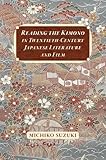Reading the Kimono in Twentieth-Century Japanese Literature and Film / Michiko Suzuki.
Material type: TextPublisher: Honolulu : University of Hawaii Press, [2023]Copyright date: ©2023Description: 1 online resource (336 p.) : 36 illustrations, 16 in colorContent type:
TextPublisher: Honolulu : University of Hawaii Press, [2023]Copyright date: ©2023Description: 1 online resource (336 p.) : 36 illustrations, 16 in colorContent type: - 9780824896935
- 895.63/44 23//eng/20230404eng
- PL747.67.K445
- online - DeGruyter
| Item type | Current library | Call number | URL | Status | Notes | Barcode | |
|---|---|---|---|---|---|---|---|
 eBook
eBook
|
Biblioteca "Angelicum" Pont. Univ. S.Tommaso d'Aquino Nuvola online | online - DeGruyter (Browse shelf(Opens below)) | Online access | Not for loan (Accesso limitato) | Accesso per gli utenti autorizzati / Access for authorized users | (dgr)9780824896935 |
Frontmatter -- Contents -- Preface -- Note on Names and Terms -- 1. Introduction: Kimono as Object, Language, and History -- 2. Literary Kimonos in The Makioka Sisters: From Prewar to Postwar -- 3. Visual Kimonos in The Makioka Sisters: The Occupation and the Bubble Economy Eras -- 4. Voices of Resistance: Kimonos in Tsuboi Sakae’s 1940s–1950s Works -- 5. Deciphering the Geisha World: Literary and Visual Kimonos in Kōda Aya’s Flowing -- 6. Kimono Lessons: Kōda Aya’s Kimono and Its Afterlife -- 7. Lost Kimonos: Writing the Self in Miyao Tomiko’s I-Novels -- Conclusion: Into the Twenty-First Century -- Notes -- Bibliography -- Index -- About the Author
restricted access online access with authorization star
http://purl.org/coar/access_right/c_16ec
Often considered an exotic garment of “traditional Japan,” the kimono is in fact a vibrant part of Japanese modernity, playing an integral role in literature and film throughout the twentieth century. Reading the Kimono in Twentieth-Century Japanese Literature and Film is the first extended study to offer new ways of interpreting textual and visual narratives through “kimono language”—what these garments communicate within their literary, historical, and cultural contexts. Kimonos on the page and screen do much more than create verisimilitude or function as one-dimensional symbols. They go beyond simply indicating the wearer’s age, gender, class, and taste; as eloquent, heterogeneous objects, they speak of wartime and postwar histories and shed light on everything from gender politics to censorship. By reclaiming “kimono language”—once a powerful shared vernacular—Michiko Suzuki accesses inner lives of characters, hidden plot points, intertextual meanings, resistant messages, and social commentary. Reading the Kimono examines modern Japanese literary works and their cinematic adaptations, including Tanizaki Jun’ichirō’s canonical novel, The Makioka Sisters, and its film versions, one screened under the US Occupation and another directed by Ichikawa Kon in 1983. It also investigates Kōda Aya’s Kimono and Flowing, as well as Naruse Mikio’s 1956 film adaptation of the latter. Reading the Kimono additionally advances the study of women writers by discussing texts by Tsuboi Sakae and Miyao Tomiko, authors often overlooked in scholarship despite their award-winning, bestselling stature. Through her analysis of stories and their afterlives, Suzuki offers a fresh view of the kimono as complex “material” to be read. She asks broader questions about the act of interpretation, what it means to explore both texts and textiles as inherently dynamic objects, shaped by context and considered differently over time. Reading the Kimono is at once an engaging history of the modern kimono and its representation, and a significant study of twentieth-century Japanese literature and film.
Mode of access: Internet via World Wide Web.
In English.
Description based on online resource; title from PDF title page (publisher's Web site, viewed 25. Jun 2024)


